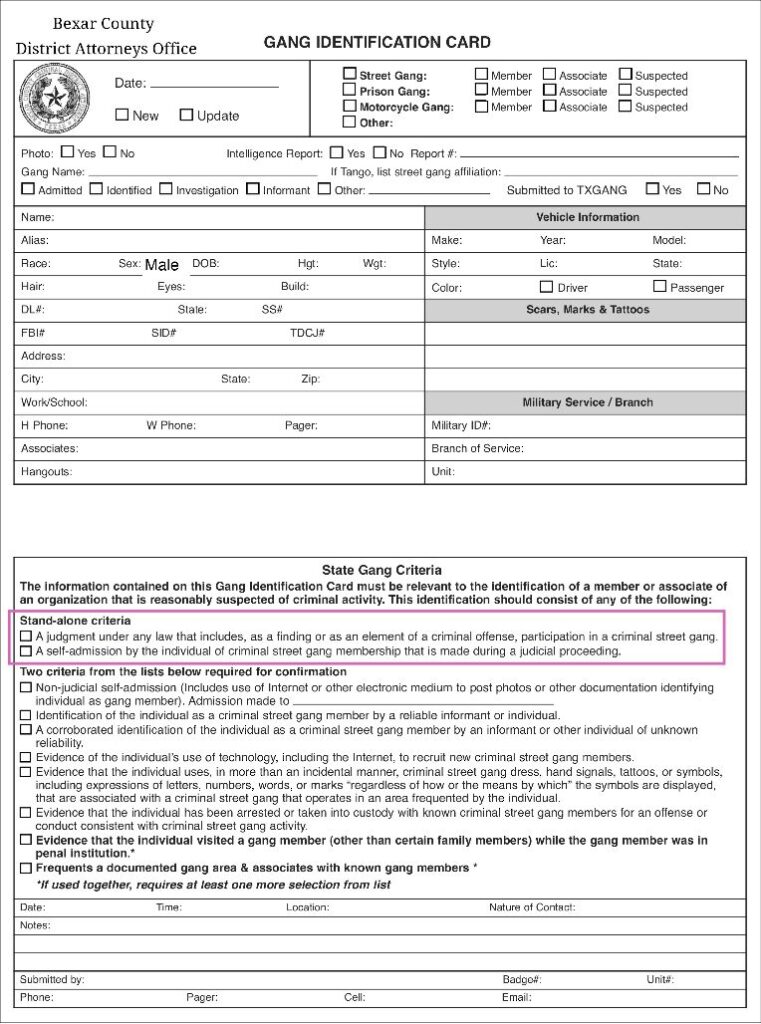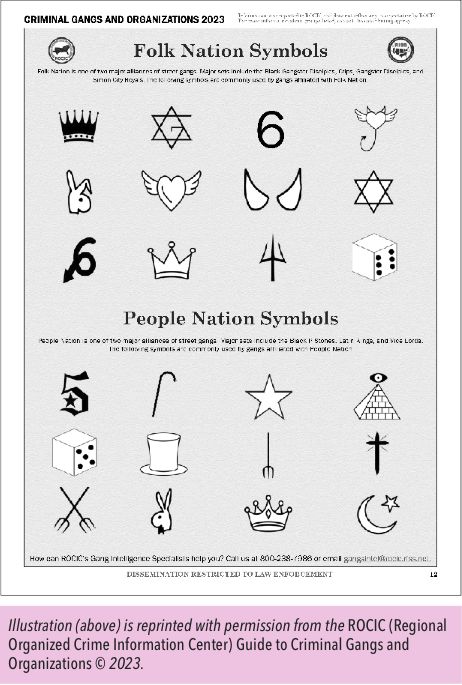By Sergeant Investigator Anthony J. Rodriguez
Criminal Investigator, Bexar County Criminal
“My defendant is a gang member. What do we do now?” I’ve heard this question many times throughout my career as a professional criminal investigator and recognized gang expert—not just from prosecutors, but also from other investigators. To address this question, we will explore a world that many may not typically consider: corrections (that is, jail or prison).
I began my law enforcement career as a jailer assigned to the Classification Section. My primary responsibility was housing inmates. To do this, I needed to know detailed information about each arrestee to ensure they were housed appropriately. This required understanding various factors, including (but not limited to) mental health, medical issues, risk potential, and most importantly for purposes of this article, gang affiliation.
The process of housing a gang member shares striking similarities with proving an individual is a gang member in court. The required evidence typically consists of an admission of gang affiliation. Fortunately, Corrections has been documenting gang affiliation for decades. The document that establishes gang affiliation goes by many names. I’ve heard it referred to as a gang letter, gang confirmation form, gang card, (insert color) form, and gang sheet. Officially Bexar County uses a Gang Identification Card, but we usually call them gang letters. One is printed on the opposite page; you can also find one as a PDF on the TDCAA website with this article. Regardless of the name, these forms are designed to capture an inmate’s admission of gang membership. These forms were originally created by Corrections to house arrestees and retain information about their gang affiliations for future incarcerations. Eventually, legislators caught up with Corrections and recognized the negative impact of gang membership on communities and enacted laws to legally document gang affiliation.
Initially, the gang letter was designed to document an individual’s identifying information and gang affiliation. The basic information included was simple and expected: name, date of birth, Social Security number, and other common identifiers. Over time, the gang letter evolved to include more detailed information about the gang, such as the date of joining, location of entry, reasons for joining, gang tattoos, aliases, and the individual’s status within the gang. An important aspect of gang letters, particularly those obtained from Corrections, is that many are signed by the defendant!
Article 67.054(b) of the Code of Criminal Procedure standardizes the gang letter by properly defining the criteria for legally identifying an individual as a gang member. As a result, a standardized gang letter features boxes to be checked at the bottom of the form. Have you seen this standardized form? Have you ever paid attention to those boxes or read them?
The standardized gang letter is divided into two portions. The first is the “Stand-Alone Criteria” (in the pink box, below). This portion is rarely used by law enforcement officers because it was created for use in judicial settings. Many prosecutors miss the opportunity to document a known gang member using this section. There are two items to select within the “Stand-Alone Criteria.” The first box states, “A judgment under any law that includes, as a finding or as an element of a criminal offense, participation in a criminal street gang.” This box requires a judgment from a case in which gang affiliation was acknowledged on the record during the trial or hearing and the participation in the gang was an element of the criminal offense.

The second box states, “A self-admission by the individual of a criminal street gang membership made during a judicial proceeding.” This box should be checked when gang affiliation is acknowledged by the defendant during an official judicial proceeding. Pre-sentencing investigations or sentencing hearings are common opportunities to check this box especially when the defendant testifies.
Below the Stand-Alone Criteria, there is a separate set of criteria. This second portion requires a minimum of two boxes to be selected. This section should be the focus for law enforcement when obtaining acknowledgment of gang affiliation. It was designed to be used by law enforcement outside a judicial setting because it indicates a self-admission, which is the most acceptable form of acknowledgment, especially in Corrections. Remember, Corrections documents gang affiliation for housing purposes. It is in the best interest of many gang members to acknowledge their affiliation so they can be housed with fellow gang members or, more importantly, avoid being housed with rival members.
Eight criteria
There are a total of eight criteria of which a minimum of two must be selected. The first criterion is the most common and should be essential for any law enforcement officer seeking self-admission. It states, in part, “Non-judicial self-admission.” This item is for when a member verbally admits gang membership to an officer. This box is the most useful because it represents a direct self-admission.
Second, “An identification of the individual as a member of a criminal street gang [or foreign terrorist organization (FTO)] by a reliable informant or other individual.” This is an often-missed opportunity. Many jail staff—including classification officers and lead detectives—can serve as reliable informants to identify the individual as a gang member. Jail staff are often aware of gang membership through jail intelligence (e.g., jail mail, phone calls, visual sightings of gang hand signs, and incident reports). Lead detectives who are familiar with the case’s facts, as well as their training and experience, can also confidently identify a gang member.
Third, “A corroborated identification of the individual as a member of a criminal street gang [or FTO] by an informant or other individual of unknown reliability.” This criterion is less frequently used because it depends on the testimony of a witness or known associate, and the reliability of that information must be corroborated.
Fourth, “Evidence of the individual’s use of technology, including the internet, to recruit new members of a criminal street gang [or FTO].” This criterion is useful for law enforcement and criminal analysts monitoring social media for gang activity.
Fifth, “Evidence that the individual uses, in more than an incidental manner, criminal street gang [or FTO] dress, hand signals, tattoos, or symbols, including expressions of letters, numbers, words, or marks that are associated with a criminal street gang [or FTO].” This criterion should be used as often as the first because it captures another common form of gang admission: non-verbal self-admission. Non-verbal self-admission is commonly seen in gang-related tattoos, hand signs, clothing, and graffiti. See the graphic below for some common examples.

Sixth, “Evidence that the individual has been arrested or taken into custody with known members of a criminal street gang [or FTO] for an offense or conduct consistent with gang activity.” This should be used with the testimony of the arresting officer or lead detective.
Seventh, “Evidence that the individual has visited a known member of a criminal street gang [or FTO], other than a family member, while the member is confined in or committed to a penal institution.” This requires testimony from someone aware of the visit and able to articulate that the incarcerated individual is a documented gang member.
Lastly, “Evidence that the individual frequents a documented area of a criminal street gang or FTO and associates with known members of a criminal street gang or FTO.” This relies on the testimony of law enforcement officers or residents who can identify a neighborhood as being occupied by criminal street gangs. Many officers can make this identification based on their experience, training, and knowledge of the area.
Obtaining a gang letter
Now that we know how to document an individual as a gang member, how does a prosecutor or DA investigator obtain these gang letters? As mentioned earlier, gang letters are most often obtained by correctional staff. Look at the Code of Criminal Procedure, specifically Article 67.051. It states, “(a) Subject to Subsection (b), a criminal justice agency or juvenile justice agency shall compile criminal information into an intelligence database for the purpose of investigating or prosecuting the criminal activities of combinations, criminal street gangs, or foreign terrorist organizations.” This law requires that a central database be maintained for all law enforcement agencies to submit their gang data, and that database is TxGang.
What is TxGang, the central gang database?
TxGang is maintained by the Texas Department of Public Safety. Law enforcement agencies are required to submit gang letters if their jurisdiction meets the population threshold (a city with a population of 50,000 or more or a county with a population of 100,000 or more). At the time this article was written, TxGang reported that there are currently 559 participating agencies in Texas, with 291 contributing gang data. There are 56,360 documented gang members across 11,305 gangs entered in TxGang (https://securesite.dps.texas.gov/DpsWebsite/Login.aspx).
The Bexar County Criminal District Attorney’s Office currently has 60 DA investigators with access to TxGang. As the agency administrator, I ensure that all investigators are trained to use the system, enabling them to determine whether a defendant is a documented gang member and retrieve the relevant gang letter. I highly recommend that other DA offices adopt similar practices. It ensures that prosecutors are better informed when making decisions as they navigate cases through the legal system.
Why is the gang card important?
I’ll pose a different question: Why do DA investigators provide prosecutors with criminal histories? It allows prosecutors to make more informed decisions and ensure that cases are indicted correctly. I would argue that gang information serves the same purpose. Consider this: What if the prosecutor is considering probation for a defendant? There are specific stipulations for documented gang members. What about crimes directly related to gang membership? For example, unlawful possession of a firearm (Penal Code §46.04) and engaging in organized criminal activity (Penal Code §71.02).
Ultimately, this information is critical for prosecutors, and the gang letter is a powerful tool they should utilize. Legislators have created databases including TxGang to make this information available to law enforcement. It is essential that prosecutors and investigators not only understand but fully embrace this valuable resource to strengthen their cases.